A message to new disc golfers:
If you are new to the sport of Disc Golf, I want to wish you the warmest of welcomes! We are super glad to have you and glad that you are taking time to do your research in order to learn more about this great sport and better your game. Below you will find enough information to at least get you started, if not get you to begin excelling at this wonderful past-time!
I think the three of us would agree, we wish we would have had this excellent resource when we started playing. Feel free to print this out and carry it with you to your local pro-shop or order the discs you believe fit you by following their respective links to infinitediscs.com where you can choose the right weight, plastic, color, and stamp that fits your particular needs.
Before we move on, I would like to introduce Zach, Tim, and I and give a little bit of our background and why you should be listening to us or reading this text.
WHO WE ARE
My name is Patrick McCormick. I have been playing Disc Golf for 18 years and I can’t tell you how much enjoyment it has brought to my life. In November of 2014, I released a book called Zen & The Art of Disc Golf which has since become a best-seller in the realm of disc golf. In 2015 I began the Zen Disc Golf Podcast to further express my love for this sport and reach as many people as I can.
Zach Engelhart is my good buddy. We met at a book signing and immediately hit it off. Zach was such a supporter of what I do (and an all around funny guy) that I asked him to join me in co-hosting the Zen Disc Golf Podcast. His knowledge of the sport and disc flight by far surpasses mine and that has made him an excellent addition to the show as he helps fill in the gaps with all his disc knowledge.
Tim Steward runs the blog www.mindbodydisc.com. Tim and I have very similar thoughts on sports psychology as it relates to the game. He has a wealth of knowledge that is both deep and wide. He also has such an eloquent way of describing scientific things in a way the rest of us can understand.
Now that you know who we are, lets dig into the wealth of information we recorded on Episode 9 of the ZDGP which discusses Disc Golf 101 as it relates to both beginners and intermediates. Although our target here is beginner and intermediates, I believe the 3 of us learned a great deal as well from our answers.
WHAT IS THE BEST THING ABOUT DISC GOLF?
TIM – Wow, I have to pick one!? For me, honestly it’s being outside. I love being outside and it makes me go outside a whole lot more than I think I would otherwise. The second best thing is a real close one, it’s a way to compete with yourself. It’s always a quest to get better than you were the day before and theres not a whole lot of things that make you do that.
ZACH – For me, I can relate this back to [Pat’s] book, it’s a walking meditation. I have a very high speed and very stressful job. It’s the most healthy and most practical way that I have found to distance myself from those negative instances from job stress and just simply throw a disc and chase a perfect flight and it allows me to come home with a clear head and be a better parent, better husband, and just a better human being. So for me, it’s the walking meditation.
PAT – For me, also the same things, probably a combination of those things. It would be real difficult for me to pick out my favorite thing. Chasing that perfect flight – when you see that disc do exactly what it’s supposed to do, man is that a “high” or what? And the sound of those chains! Once you hear those chains, you never turn back. So, I agree with you too – get’s you out in nature. Gets you some of that vitamin D. Gets you some sunlight. It’s good for your mind, good for your body, and it’s good for your spirit.
What advice would you give to a new Disc Golfer, who has played one round ALREADY and wants to get started?
TIM – The best advice I can give to a new Disc Golfer is to play with the right discs and start with maybe one or two. You see so many of these new folks going out to the course and no matter how many good tips they have been given, if they are playing with the crazy overstable, high speed drivers, they are not going to have a good time. I can’t tell you how many times I have taken a FIREBIRD, an EAGLE, or a DESTROYER out of a new Disc Golfer’s hands and put in their hands a LEOPARD or just something nice and easy to throw. The look on their faceS when they throw that disc and actually get it to go straight and far for the first time is priceless. I think if you throw a neutral mid-range as your first disc – something you can get to go straight, something you can get to hyzer, something you can get to go right or left, something like that is a good choice and it teaches you to throw well. I think sometimes newer players don’t realize just how far you can throw a midrange.
ZACH – The only way I can add to that is to say that once you have some good discs selected, find a good group of players that will elevate your game. That’s what worked for me. I started playing in the weekly in Pensacola, and getting the snot kicked out of me, but it improved my game to a level that I [would have] never played at and I learned a lot by watching how they played, how they stayed calm, and they gave me tips and tricks as I went along the way and ultimately shaped me into the golfer that I am now.
PAT – I absolutely agree with both of those answers. I can’t add much else to that. That is probably the two best tips.
What first discs would you recommend to a new player?
TIM – To name a few specifically, I would say I really like the COMET [4,5,-2,1] from DISCRAFT
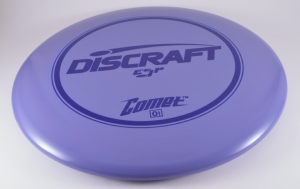
The FUSE [5,6,-2,1] from LATITUDE 64 which is a very similar disc.
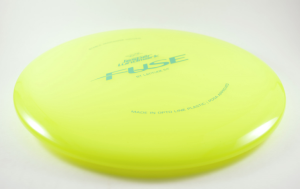
If you can find a beat up (used) ROC [3,3,0,2] (INNOVA), that would be a great disc to start with.
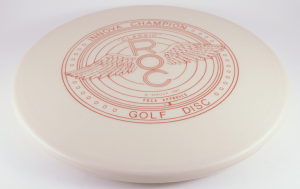
Any midrange that goes straight is a great choice.
ZACH – Tim is a jerk, he stole some of the discs I was going to use. I think that every player should have a BUZZZ [5,5,0,1] (DISCRAFT) . Particularly a nice beat in one. That’s one of my favorite discs to throw.
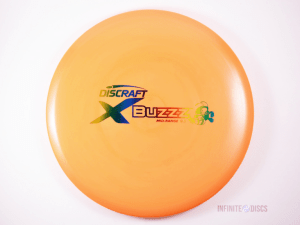
Also, start with a putter, if you can. A putter and a straight mid. I think the COMET (DISCRAFT) is a great one because it teaches you good form. You are not trying to manipulate anything you have to throw it straight to get it to go straight.
PAT – My discs would be… and I agree with a BUZZZ (DISCRAFT), it is a great one, but I am now a big fan of the CLAYMORE [5,5,0.5,-1] (LATITUDE 64). I recommend a CLAYMORE
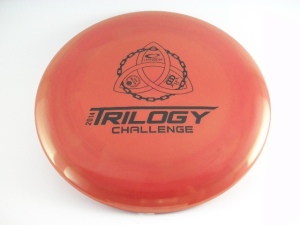
and either a KC-PRO AVIAR [2,3,0,2] (INNOVA)
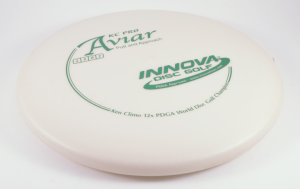
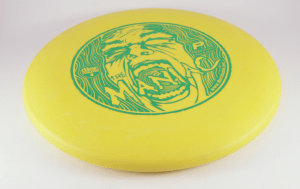
So again, that’s stable midranges and stable putters all around.
WHAT DRIVERS WOULD YOU RECOMMEND FOR PLAYERS THAT ARE READY TO MOVE UP TO A DRIVER?
TIM – Again, something that goes straight, something they can get a little bit of “flex” out of (for folks who don’t know what “flex” is, it’s when you can throw it and it turns over right for a little bit and glides for a while. So something like a LEOPARD [6,5,-2,1] (INNOVA) is a fantastic first driver.
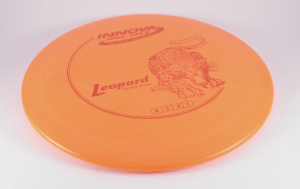
From what I throw in my bag, the VISION [8,6,-2,2] by LATITUDE 64 is a very similar disc.
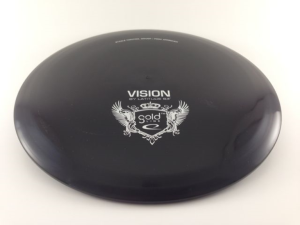
You mentioned in the last episode, a SEER [7,5,-1,2] (WESTSIDE), any of those would be great first choices.
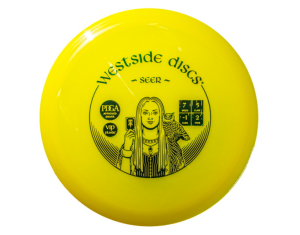
ZACH – I swore by an ORION LS [9,5,-2,2] (MILLENNIUM)
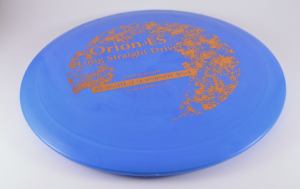
But I am also a huge fan of the MVP DISCS INERTIA [11,5,-2,2]
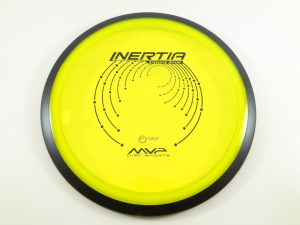
I can throw an INERTIA and get it to flex a lot off of a backhand… [But] if you are a new golfer and you want a new driver, and you think – “Oh, I want a 177 [gram], No you knock it off. [Both Zach and Pat agree] Get a 155, get a 160, so you can throw it a little farther and so you are not so disappointed – it’s going to flex more.
PAT – So, I have a lot of recommendations for a first driver. All of them have very similar flights, while you all were talking, I added more to my list. LEOPARD (INNOVA), I am going to overlap with Tim. An INNOVA LEOPARD is a great first disc. VALKYRIE [9,4,-2,2] (INNOVA), very similar to a LEOPARD is also a great first disc.
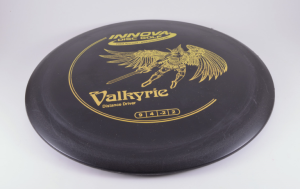
A DISCRAFT STALKER [8,5,-1,1] – The first time I ever saw one, someone described it as a BUZZZ (DISCRAFT) on steroids. So if you are already out there throwing a BUZZZ, then that might be a good transition disc.
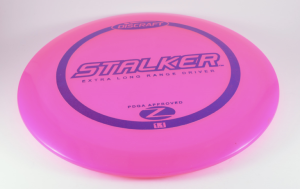
Then, I have 2 more which I have been throwing recently that I think might be good. These are little more obscure, but a VIBRAM TRAK [7,4,-1,2].
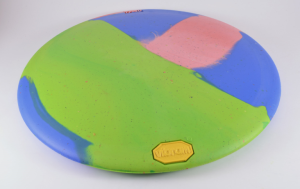
And an AXIOM CRAVE [6,5,-1,1] [In the audio, I stated an ALIAS [5,5,-1,1] when I meant a CRAVE. The ALIAS is also a great disc but technically a midrange. I was thinking CRAVE and said ALIAS – Indicative of the need of more coffee (or maybe too much coffee)]
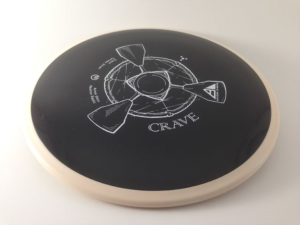
I lost my VIBRAM TRAK – but I’m going to go ahead buy 3 more. Super stable – lots of glide – beautiful flight.
Explain the 4 numbers on disc golf discs – SPEED, GLIDE, TURN, and FADE.
TIM –
Speed – The most misunderstood number especially for new players who may go into the store and then they see those 12s, 13s, 14s, even 15s (and this was me, I went into to the sporting goods store and I bought the driver with the highest speed number on it as my first disc and it was a BIG mistake). Really that speed number only means two things:
(1) How quickly will it slow down. So the higher the speed number, the less it will slow down so it will maintain its [spinning] speed for a longer period of time. The resistance or drag is lower on a high speed driver, so it will maintain its spin and speed a lot longer in the air. A putter is a very low speed – it has a blunt nose so it slows down a lot quicker than a higher speed driver…
(2) That [speed] number is indicative how fast you need to be able to throw the disc in order for it to do what those other 3 numbers say. So, if it says it’s going to turn or fade a certain amount then you have to be able to throw the disc at speed 14 (if it’s a speed 14 disc) for those other numbers to be true. When you look at flight charts online and you see the path of the disc, and you see how that disc is supposed to fly – it is dependent upon you actually being able to throw it that speed number. So what I find is a lot of new players (and myself included for a while)… I backed down and my primary driver was a speed 12 – because that seems to suit my arm speed the best. I can actually throw a speed 12 driver farther than I can throw a speed 13, 14, or 15 driver. My go to 12 speed driver is a TRESPASS (DYNAMIC DISCS). I can get that to flex. I can throw it the way I am supposed to because I can throw it at the speed that it likes to be thrown. So, maybe the better way to say that is the speed number is that speed that disc likes to be thrown.
Glide – Glide is pretty straight forward. It’s the time that disc will stay in the air with little effort. So for example, I like midranges with a lot if glide because I don’t have to power them, I don’t have to throw them as hard as I can for them to go a long way. The SEER (WESTSIDE) is another disc that glides forever, you don’t have to throw it that hard and it just kind of sits up flat and angles and glide. I kind of compare that to to if you throw a Frisbee on a beach, those have a ton of glide. They stay in the air with very little effort. So the higher the number, the better the glide.
ZACH –
Turn – The turn is the discs resistance to high speed. So this is what happens when the disc comes out of your hand at the recommended speed, it is how much it will flex one way or another. So for the purpose of this conversation, we will talk about a right handed backhand (RHBH) [throw]. If you were to throw a disc on a RHBH, it should in theory land with fade to left if it’s just a normal stable driver… A good normal stable disc with have 0 turn and the more under stable you go will be your negative numbers, -1, -2, -3, and I think one or two discs even go to -4. I think that would be the VULCAN (INNOVA). Those negative numbers are the resistance to high speed turn. So when you throw it on a RHBH that disc will flex to the right and then slowly work its way back to the left [in an S curve] and that’s where your fade comes in.
Fade – Your [turn] and your fade are closely related as far as the flight path of the disc with your fade (being a 1, 2, 3, or even a 0) is how much that disc is going to come back to the left [on a RHBH]. This is your resistance to low speed turn. That’s when the disc is slowing down at the end of the flight. How much it will come back to the left off of your right handed back hand throw. Those two numbers go hand in hand and thats where you see your flight path – and that’s how you can shape shots. These numbers help you decide what disc to select should you have a tight window, or a curve in the fairway, a dogleg, etc.
WHAT IS THE DIFFERENCE BETWEEN AN OVERSTABLE DISC AND AN UNDERSTABLE DISC?
TIM – The first thing I am going to point out is depending on where you live in the country, these words may have different meanings for different people that you play with. If you look online, this subject is the source of more fights on disc golf forums than many other things – one persons calls a disc overstable and another person says your using the word wrong. So, I am going to give my interpretation of it, just based on what the actual definitions of these types of words mean.
Stable Discs – For me, a stable disc means that it holds the line that you put it on. So, if you throw it straight – it goes straight. If you throw it on an anhyzer, it holds that anhyzer line and it’s stable throughout the line you threw it on. If you throw it on a hyzer line, it stays on the hyzer line. And for newer folks, all hyzer means if you are a RHBH player – the outer edge of the disc thats furthest from your hand is lower that the edge in your hand so it will tend to go left. An anhyzer is the opposite, the outside edge than the edge in your hand so the disc tends to go right. But a stable disc is stable through its flight so it holds whatever line you put on it. So if you are throwing a stable disc and it is going to the right, that is because you started it with an anhyzer angle.
Overstable Discs – Overstable basically means that as the disc slows down it will dump to the left from a RHBH. So if you throw it flat – an overstable disc has a tendency to fall out the air to the left. And the more overstable it is, the fast it starts to go left and the more severe of an angle it pitches into as it goes left.
Understable Discs – An understable disc is going to do the opposite. If you throw it flat [on a RHBH], its tendency will be to go right. And if we are to tie that to Zach’s really good explanation of the turn and fade numbers, an understable disc is going to have a turn of -2, -3, and -4 and overstable disc will have a turn rating of 0 usually accompanied by a fade rating of 2, 3, or a 4.
AS A NEW PLAYER, WHY ON EARTH WOULD I WANT A DISC THAT IS NOT STABLE?
ZACH – It will give you a little extra distance and you can learn in an easier way how to work an anhyzer. I wish I would have known years ago that I could use an under stable disc to figure out how to throw an anhyzer because some people just can’t throw a flick [A forearm throw] but they need a disc to go to the right. That’s where I stand on that one.
LIST SOME REALLY OVERSTABLE DISCS AND SOME REALLY UNDERSTABLE DISCS.
OVERSTABLE DISCS –
Zach – NUKE [13,5,-1,3] (DISCRAFT)

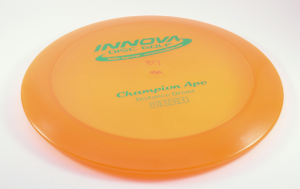
MISSILEN [15,3,0,4] (LATITUDE 64)
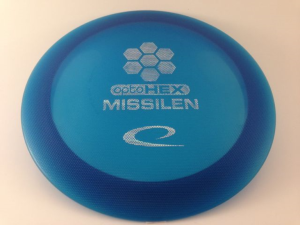
VIPER [6,4,1,5] (INNOVA) (Notice how the Viper’s Turn rating is +1 making this disc really short and extremely overstable.
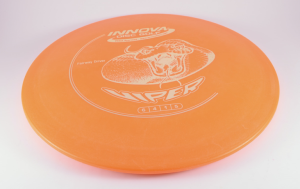
WHIPPET [6,4,1,5] (INNOVA) (Same ratings as a Viper)
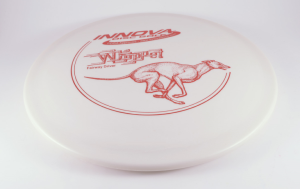
Zach – If you are a new player and you want to get a WHIPPET – NOPE – DO NOT.
Pat – Yes this is your list of discs NOT to get until you are really able to throw those putters and midranges.
UNDERSTABLE DISCS –
Zach – And for understable discs (great for beginners) I would tell you just go ahead and get you a KITE [5,6,-3,1] (INNOVA),
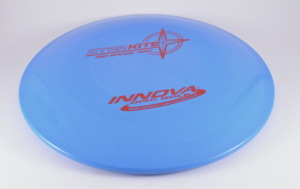
A SEER [7,5,-1,2] (WESTSIDE DISCS),

or an UNDERWORD [7,6,-3,1] (WESTSIDE DISCS).
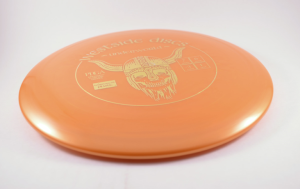
Those are all ones that I have either thrown or seen thrown well as understable discs and I think they WILL work for a beginner, but again it’s all subjective and you’ll be the judge of that as the individual player.
TIM – Those are great recommendations.
This completes Disc Golf 101 – The Ultimate Guide for Disc Golf Beginners.
For more information, listen to Episode 9 of the podcast for more information about the history and some of the more obscure rules and regulations.
Also check out the PDGA Rulebook for everything else you need to know on the course on how to actually play this great game!


Hey Patrick, did you know my DVD, “Disc Golf 101” has been out for about 15-20 years?